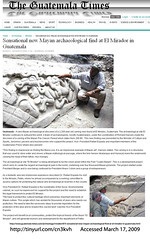Overdose of cuteness and surprise.
Tuesday, March 31, 2009
Tuesday, March 17, 2009
Zapotec lost treasures photo gallery
National Geographic has a couple of articles up on the Zapotecs, another Mesoamerican/Precolumbian society. The first one is a photo gallery of 7 artifacts from El Palmillo (one of the photos is shown above, of a palace excavation).
Hopefully NatGeo will keep the gallery up. I have a condensed screenshot but it's worth looking at the originals.

Hopefully NatGeo will keep the gallery up. I have a condensed screenshot but it's worth looking at the originals.

Labels:
El Palmillo,
Mexico,
monte alban,
zapotec
Zapotec society in Mexico
The other article National Geographic has about the Zapotecs talks about the rise and fall of their civilization. Most people have heard of the Aztecs, the Maya, and even the Olmecs (because of the giant heads) but few know about the Zapotecs. The NG article sums them up: For 1,500 years, the agrarian Zapotec state spanned 800 square miles (2,000 square kilometers) and was home to at least 100,000 people. The Zapotec were pioneers in the use of agriculture and writing systems. They were gifted weavers and ceramic artisans. They built Monte Albán, one of the earliest cities in the Americas, and established a remarkably organized bureaucratic structure.
U.S. archaeologists Gary Feinman and Linda Nicholas have been excavating an ancient city called El Palmillo, near Oaxaca, unraveling what happened to the once thriving center of 5,000 residents. They have uncovered graves, palaces and a ball court but only have scant theories on what happened to El Palmillo or why it collapsed.

(Photo source; screenprint of article)
U.S. archaeologists Gary Feinman and Linda Nicholas have been excavating an ancient city called El Palmillo, near Oaxaca, unraveling what happened to the once thriving center of 5,000 residents. They have uncovered graves, palaces and a ball court but only have scant theories on what happened to El Palmillo or why it collapsed.

(Photo source; screenprint of article)
Labels:
archaeology,
Mexico,
news,
zapotec
Location:
Oaxaca, OA, Mexico
Popul Vuh carving found at El Mirador
Archeologists have found a 2200 year old carving in Guetamala that appears to show a scene from the Popol Vuh
(the Mayan creation myth), according to Guatemala News. Richard Hansen, whose team found the carving, compares it to the Mona Lisa. The carving is in a structures (sic) that was used to store water and shows a Mayan mythological passage, where the twin heroes Ixbalanque and Hunacpú leave the underworld carrying the head of their father, Hun Hunapú.Supposedly El Mirador is going to be part of the largest archeological park in the world, called Cuatro Balam (Fourth Jaguar?), which will include over 4,000 pyramids. That's pretty cool.

(picture source=article source; screenprint of original)
Labels:
archaeology,
el mirador,
mayan,
popol vuh,
pyramid
Location:
El Mirador, Guatemala
Friday, March 06, 2009
The Long Count & 2012
Here's some basic information on the Long Count and 2012 that I just put together for an answer at Askville.
The people of Meso-America had a series of elaborate calendars. One of them was the Long Count, which is simply a count of days since what they think was the beginning of the world (~3113 BCE). It's like an odomoter. A Long Count date is a series of 5 numbers--today's date is 12.19.16.2.14, for instance (March 6, 2009).
Basically that means it has been (12x144,000)+(19x7,200)+(16x360)+(2x20)+(14x1) days since they think the world began. (1,728,000)+(136,800)+(5760)+(40)+(14)=1,870,614 days-- or almost 5125 years.
On 12-21-2012, the Long Count date will be 13.00.00.00.00. This is in NO WAY the end of the Long Count--it can go up to 19 and then another set of numbers would be added (1.00.00.00.00.00, but that's thousands of years away).
Although 13 was a sacred number to the Maya, and they celebrated any turning of the Baktuns (we'll be going from Baktun 12 to Baktun 13), they did not believe the world was ending.
Some authors have popularized the concept of a "galactic alignment" on that date, but there is no evidence that the Maya recognized this alignment or knew about it or indeed planned the Long Count so that the first day of Baktun 13 would fall at the time of the alignment.
The alignment itself is nebulous--the winter solstice sunrise coming up in a certain area of the sky. Although it takes 26,000 years for this alignment to happen again, the sky rotates so slow (precession of the equinoxes) that we could have assigned the actual "alignment" to be any winter solstice for the last few (or next few) years. The human eye can't detect precession without instruments.
The theory behind this alignment is that because the Maya thought that area of the Milky Way (where the sun will be that morning) was the birthplace of stars, and the sun (a star) is rising through it, that means the sun is being reborn and a new world age is becoming.
The people of Meso-America had a series of elaborate calendars. One of them was the Long Count, which is simply a count of days since what they think was the beginning of the world (~3113 BCE). It's like an odomoter. A Long Count date is a series of 5 numbers--today's date is 12.19.16.2.14, for instance (March 6, 2009).
Basically that means it has been (12x144,000)+(19x7,200)+(16x360)+(2x20)+(14x1) days since they think the world began. (1,728,000)+(136,800)+(5760)+(40)+(14)=1,870,614 days-- or almost 5125 years.
On 12-21-2012, the Long Count date will be 13.00.00.00.00. This is in NO WAY the end of the Long Count--it can go up to 19 and then another set of numbers would be added (1.00.00.00.00.00, but that's thousands of years away).
Although 13 was a sacred number to the Maya, and they celebrated any turning of the Baktuns (we'll be going from Baktun 12 to Baktun 13), they did not believe the world was ending.
Some authors have popularized the concept of a "galactic alignment" on that date, but there is no evidence that the Maya recognized this alignment or knew about it or indeed planned the Long Count so that the first day of Baktun 13 would fall at the time of the alignment.
The alignment itself is nebulous--the winter solstice sunrise coming up in a certain area of the sky. Although it takes 26,000 years for this alignment to happen again, the sky rotates so slow (precession of the equinoxes) that we could have assigned the actual "alignment" to be any winter solstice for the last few (or next few) years. The human eye can't detect precession without instruments.
The theory behind this alignment is that because the Maya thought that area of the Milky Way (where the sun will be that morning) was the birthplace of stars, and the sun (a star) is rising through it, that means the sun is being reborn and a new world age is becoming.
Subscribe to:
Posts (Atom)











